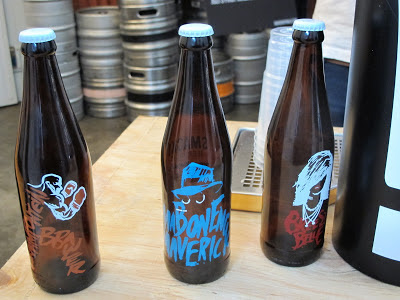This
Sunday we headed down to Maboneng's Sunday market, Market on Main to
shop, eat, drink and look into the properties on offer in this
growing inner-city gentrification project.
Somewhat
similar to the Sunday pop-up markets in London's Brick Lane, Market
on Main is largely focused on selling fresh food made from local
products cooked right in front of you. Stalls sell all kinds of tasty
things such as Thai noodles, dim sum, Ethiopian platters, gourmet
burgers, sizzling paella, Durban style curries and barbequed pork
ribs. On the drinks side there's homemade lemonade, mojitos, craft
beers (that's South African for real ale/microbrewery), good strong
Ethiopian coffee and, as we are now in South African winter, hot
toddys and mulled wine. The food hall is constantly jam packed with
fashionable foodies grabbing lunch at the communal tables and is
hectic, but in a festive way.


On the
upper floor of the former warehouse is a smaller market selling
vintage clothes, funky furniture, handmade jewellery, artworks and
some beautiful African fabric inspired shoes and handbags. The
selection is small, but enticing. Back down in the warehouse's
courtyard entrance you can also find little studios with art
exhibition spaces and galleries, which form both the creative and
commercial spaces of the artists who live here.


During
our exploration of these little studios surrounding the market we
came across the Smack! Republic Brewery (do they know that 'smack' is
slang for heroin in the UK...?!). Smack! is two months old and run by
two young craft beer lovers who had the dream of creating Joburg's
first inner-city microbrewery. Their brewing space was most
definitely micro - I think even my local pub in England has a bigger
production - but we could not fault the beer. This was absolutely
delicious, seriously some of the best I have drank in a long time. I
can't wait to find it in some bars around town. And check out the
bottles, very cool.
 |
| At Smack!'s terrace, fancy loft conversion in the background |
Bargain Maboneng property
As we
sat up on Smack!'s balcony with our pints of Bree Street Belle, we
spotted a house viewing across the courtyard. We had landed in
Maboneng on open day and the local sales team were there in force to
tell us about the area's excellent investment gains. Apparently
properties here see about a 12-14% yearly value increase, easily
beating inflation. Furthermore, by 2015 the Maboneng precinct plan to
develop an incredible 25 more buildings which they now own in the
area (I didn't quite catch what that means in unit numbers, but I
would say they are looking at adding thousands more flats). More and
varied retail space is their next big focus (an area can't survive on
a Sunday market alone) and they also plan to build student housing to
bring some economic variation to the area, and of course to make it
really, really cool.
The
first property we saw was a converted factory loft. The ceilings were
sky high leaving potential to
add space with a mezzanine, although noticeably there were not
many windows in the main living space. The showers (two, one for each
bedroom), with old industrial windows used as doors, were about the
size of your average bathroom and from the balcony you could easily
zip-line your way over the courtyard and straight into the brewery
bar. It was a large (125sqm) and unique space, which would suite
young creatives with imagination and I can only imagine the kind of
parties they could have there. Price? 1.5million Rand, which is
around £100,000.
 |
| Designer bathroom |
Next we
moved over to Main Street Life, a seven storey building with a
boutique hotel on the top floor and an independent cinema and theatre
on street level. The cheapest properties here are the studio flats
(around 33sqm), which with their current furnishings unfortunately
resembled hotel rooms. These units are on sale for 360K (about £23K) and apparently rent for around 2,000Rand per month. For
something slightly bigger they also still had a corner studio left,
which came in at a considerably larger 55 square metres and was
surrounded on two sides by full length windows (with views). Price?
550K (about £35K).
 |
| Every floor of the building has its own artworks |
 |
| The view from the top of Main Street Life |
Maboneng
are also selling properties 'off-plan' in two other nearby building
starting at 580,000Rand for 50sqm in 'Revolution House' and
650,000Rand for a 65sqm loft style space in a building which, when
construction finishes, will offer balconies and a communal swimming
pool.
The
redevelopment of this part of the city is certainly ambitious, poses many questions and has raised its fair share of controversy. The
property mogul behind it all, Jonathan Lieberman, believes that in
order to really redevelop and lift this tough inner-city area out of
poverty and neglect, middle income and rich residents need to be
looked after, as well as the existent poor population. Hence high-end
properties, bijou dining spots and artisan shops have taken centre
stage in the first part of the development. However, many people also
argue that Maboneng currently only caters
for those with money to the detriment of the local population, and
certainly judging by the prices in the local bar I'd have to agree,
life is pricey.
 |
| More local buildings slated for redevelopment |
However,
when all is said and done, as the endless spread of Joburg's northern
residential sprawl is unsustainable, the regeneration and re-branding
of these downtown areas is essential. Getting well-off South Africans
to change their perceptions of inner-city living is a highly
commendable thing. What these new urbanites do when they get there is
another story.











































